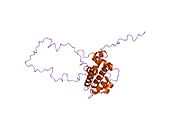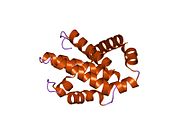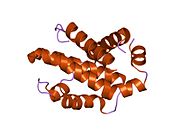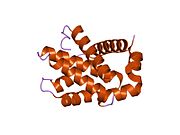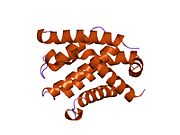Biology:BCL2-like 1
 Generic protein structure example |
Bcl-2-like 1 or BCL2L1 is a human gene. Through alternative splicing, it encodes both of the human proteins Bcl-xL and Bcl-xS.[1]
Function
The protein encoded by this gene belongs to the BCL-2 protein family. BCL-2 family members form hetero- or homodimers and act as anti- or pro-apoptotic regulators that are involved in a wide variety of cellular activities. The proteins encoded by this gene are located at the outer mitochondrial membrane, and have been shown to regulate outer mitochondrial membrane channel (VDAC) opening. VDAC regulates mitochondrial membrane potential, and thus controls the production of reactive oxygen species (ROS) and release of cytochrome C by mitochondria, both of which are the potent inducers of cell apoptosis. Two alternatively spliced transcript variants, which encode distinct isoforms, have been reported. The longer isoform (Bcl-xL) acts as an apoptotic inhibitor and the shorter form (Bcl-xS) acts as an apoptotic activator.[1][2]
Interactions
BCL2-like 1 (gene) has been shown to interact with:
- APAF1,[3][4]
- BAK1,[5][6][7][8][9]
- BCAP31,[10]
- BCL2L11,[7][11][12][13]
- BNIP3,[14]
- BNIPL,[15][16]
- BAD,[6][11][17][18][19][20][21][22][23][24][25]
- BAX,[6][18][26][27]
- BIK,[5][11][27][28]
- Bcl-2,[6][29]
- HRK,[7][30][31]
- IKZF3,[32]
- Noxa,[11][33]
- PPP1CA,[19]
- PSEN2[34]
- RAD9A,[5][17]
- RTN1,[35]
- RTN4,[35] and
- VDAC1.[36][37][38][39]
References
- ↑ 1.0 1.1 "bcl-x, a bcl-2-related gene that functions as a dominant regulator of apoptotic cell death". Cell 74 (4): 597–608. Aug 1993. doi:10.1016/0092-8674(93)90508-N. PMID 8358789. https://deepblue.lib.umich.edu/bitstream/2027.42/30629/1/0000270.pdf.
- ↑ "Entrez Gene: BCL2L1 BCL2-like 1". https://www.ncbi.nlm.nih.gov/sites/entrez?Db=gene&Cmd=ShowDetailView&TermToSearch=598.
- ↑ "Bcl-XL interacts with Apaf-1 and inhibits Apaf-1-dependent caspase-9 activation". Proceedings of the National Academy of Sciences of the United States of America 95 (8): 4386–91. Apr 1998. doi:10.1073/pnas.95.8.4386. PMID 9539746. Bibcode: 1998PNAS...95.4386H.
- ↑ "Caspase-9, Bcl-XL, and Apaf-1 form a ternary complex". The Journal of Biological Chemistry 273 (10): 5841–5. Mar 1998. doi:10.1074/jbc.273.10.5841. PMID 9488720.
- ↑ 5.0 5.1 5.2 "Towards a proteome-scale map of the human protein-protein interaction network". Nature 437 (7062): 1173–8. Oct 2005. doi:10.1038/nature04209. PMID 16189514. Bibcode: 2005Natur.437.1173R.
- ↑ 6.0 6.1 6.2 6.3 "Development of a high-throughput fluorescence polarization assay for Bcl-x(L)". Analytical Biochemistry 307 (1): 70–5. Aug 2002. doi:10.1016/S0003-2697(02)00028-3. PMID 12137781.
- ↑ 7.0 7.1 7.2 "High-throughput methods to detect dimerization of Bcl-2 family proteins". Analytical Biochemistry 322 (2): 170–8. Nov 2003. doi:10.1016/j.ab.2003.07.014. PMID 14596824.
- ↑ "Proapoptotic Bak is sequestered by Mcl-1 and Bcl-xL, but not Bcl-2, until displaced by BH3-only proteins". Genes & Development 19 (11): 1294–305. Jun 2005. doi:10.1101/gad.1304105. PMID 15901672.
- ↑ "Identification of small-molecule inhibitors of interaction between the BH3 domain and Bcl-xL". Nature Cell Biology 3 (2): 173–82. Feb 2001. doi:10.1038/35055085. PMID 11175750.
- ↑ "p28 Bap31, a Bcl-2/Bcl-XL- and procaspase-8-associated protein in the endoplasmic reticulum". The Journal of Cell Biology 139 (2): 327–38. Oct 1997. doi:10.1083/jcb.139.2.327. PMID 9334338.
- ↑ 11.0 11.1 11.2 11.3 "Differential targeting of prosurvival Bcl-2 proteins by their BH3-only ligands allows complementary apoptotic function". Molecular Cell 17 (3): 393–403. Feb 2005. doi:10.1016/j.molcel.2004.12.030. PMID 15694340.
- ↑ "Bim: a novel member of the Bcl-2 family that promotes apoptosis". The EMBO Journal 17 (2): 384–95. Jan 1998. doi:10.1093/emboj/17.2.384. PMID 9430630.
- ↑ "BOD (Bcl-2-related ovarian death gene) is an ovarian BH3 domain-containing proapoptotic Bcl-2 protein capable of dimerization with diverse antiapoptotic Bcl-2 members". Molecular Endocrinology 12 (9): 1432–40. Sep 1998. doi:10.1210/mend.12.9.0166. PMID 9731710.
- ↑ "BNIP3 heterodimerizes with Bcl-2/Bcl-X(L) and induces cell death independent of a Bcl-2 homology 3 (BH3) domain at both mitochondrial and nonmitochondrial sites". The Journal of Biological Chemistry 275 (2): 1439–48. Jan 2000. doi:10.1074/jbc.275.2.1439. PMID 10625696.
- ↑ "BNIPL-2, a novel homologue of BNIP-2, interacts with Bcl-2 and Cdc42GAP in apoptosis". Biochemical and Biophysical Research Communications 308 (2): 379–85. Aug 2003. doi:10.1016/S0006-291X(03)01387-1. PMID 12901880.
- ↑ "BNIP3alpha: a human homolog of mitochondrial proapoptotic protein BNIP3". Cancer Research 59 (3): 533–7. Feb 1999. PMID 9973195.
- ↑ 17.0 17.1 "Human homologue of S. pombe Rad9 interacts with BCL-2/BCL-xL and promotes apoptosis". Nature Cell Biology 2 (1): 1–6. Jan 2000. doi:10.1038/71316. PMID 10620799.
- ↑ 18.0 18.1 "BAD partly reverses paclitaxel resistance in human ovarian cancer cells". Oncogene 17 (19): 2419–27. Nov 1998. doi:10.1038/sj.onc.1202180. PMID 9824152.
- ↑ 19.0 19.1 "The anti-apoptotic molecules Bcl-xL and Bcl-w target protein phosphatase 1alpha to Bad". European Journal of Immunology 32 (7): 1847–55. Jul 2002. doi:10.1002/1521-4141(200207)32:7<1847::AID-IMMU1847>3.0.CO;2-7. PMID 12115603.
- ↑ "Survival function of protein kinase C{iota} as a novel nitrosamine 4-(methylnitrosamino)-1-(3-pyridyl)-1-butanone-activated bad kinase". The Journal of Biological Chemistry 280 (16): 16045–52. Apr 2005. doi:10.1074/jbc.M413488200. PMID 15705582.
- ↑ "Bad, a heterodimeric partner for Bcl-XL and Bcl-2, displaces Bax and promotes cell death". Cell 80 (2): 285–91. Jan 1995. doi:10.1016/0092-8674(95)90411-5. PMID 7834748.
- ↑ "Rationale for Bcl-xL/Bad peptide complex formation from structure, mutagenesis, and biophysical studies". Protein Science 9 (12): 2528–34. Dec 2000. doi:10.1110/ps.9.12.2528. PMID 11206074.
- ↑ "BAD/BCL-[X(L)] heterodimerization leads to bypass of G0/G1 arrest". Oncogene 20 (33): 4507–18. Jul 2001. doi:10.1038/sj.onc.1204584. PMID 11494146.
- ↑ "Synergistic anti-apoptotic activity between Bcl-2 and SMN implicated in spinal muscular atrophy". Nature 390 (6658): 413–7. Nov 1997. doi:10.1038/37144. PMID 9389483. Bibcode: 1997Natur.390..413I.
- ↑ "PCNA interacts with hHus1/hRad9 in response to DNA damage and replication inhibition". Oncogene 19 (46): 5291–7. Nov 2000. doi:10.1038/sj.onc.1203901. PMID 11077446.
- ↑ "Multiple Bcl-2 family members demonstrate selective dimerizations with Bax". Proceedings of the National Academy of Sciences of the United States of America 92 (17): 7834–8. Aug 1995. doi:10.1073/pnas.92.17.7834. PMID 7644501. Bibcode: 1995PNAS...92.7834S.
- ↑ 27.0 27.1 "Induction of cell death by the BH3-only Bcl-2 homolog Nbk/Bik is mediated by an entirely Bax-dependent mitochondrial pathway". The EMBO Journal 22 (14): 3580–90. Jul 2003. doi:10.1093/emboj/cdg343. PMID 12853473.
- ↑ "Involvement of Bik, a proapoptotic member of the Bcl-2 family, in surface IgM-mediated B cell apoptosis". Journal of Immunology 166 (10): 6025–33. May 2001. doi:10.4049/jimmunol.166.10.6025. PMID 11342619.
- ↑ "Conversion of Bcl-2 from protector to killer by interaction with nuclear orphan receptor Nur77/TR3". Cell 116 (4): 527–40. Feb 2004. doi:10.1016/S0092-8674(04)00162-X. PMID 14980220.
- ↑ "harakiri, a novel regulator of cell death, encodes a protein that activates apoptosis and interacts selectively with survival-promoting proteins Bcl-2 and Bcl-X(L)". The EMBO Journal 16 (7): 1686–94. Apr 1997. doi:10.1093/emboj/16.7.1686. PMID 9130713.
- ↑ "The cell death-promoting gene DP5, which interacts with the BCL2 family, is induced during neuronal apoptosis following exposure to amyloid beta protein". The Journal of Biological Chemistry 274 (12): 7975–81. Mar 1999. doi:10.1074/jbc.274.12.7975. PMID 10075695.
- ↑ "The association of Aiolos transcription factor and Bcl-xL is involved in the control of apoptosis". Journal of Immunology 167 (11): 6366–73. Dec 2001. doi:10.4049/jimmunol.167.11.6366. PMID 11714801.
- ↑ "Noxa, a BH3-only member of the Bcl-2 family and candidate mediator of p53-induced apoptosis". Science 288 (5468): 1053–8. May 2000. doi:10.1126/science.288.5468.1053. PMID 10807576. Bibcode: 2000Sci...288.1053O.
- ↑ "Interaction of Alzheimer's presenilin-1 and presenilin-2 with Bcl-X(L). A potential role in modulating the threshold of cell death". The Journal of Biological Chemistry 274 (34): 24007–13. Aug 1999. doi:10.1074/jbc.274.34.24007. PMID 10446169.
- ↑ 35.0 35.1 "A novel protein, RTN-XS, interacts with both Bcl-XL and Bcl-2 on endoplasmic reticulum and reduces their anti-apoptotic activity". Oncogene 19 (50): 5736–46. Nov 2000. doi:10.1038/sj.onc.1203948. PMID 11126360.
- ↑ "Specific cleavage of Mcl-1 by caspase-3 in tumor necrosis factor-related apoptosis-inducing ligand (TRAIL)-induced apoptosis in Jurkat leukemia T cells". The Journal of Biological Chemistry 280 (11): 10491–500. Mar 2005. doi:10.1074/jbc.M412819200. PMID 15637055.
- ↑ "Identification of the protein-protein contact site and interaction mode of human VDAC1 with Bcl-2 family proteins". Biochemical and Biophysical Research Communications 305 (4): 989–96. Jun 2003. doi:10.1016/S0006-291X(03)00871-4. PMID 12767928.
- ↑ "BH4 domain of antiapoptotic Bcl-2 family members closes voltage-dependent anion channel and inhibits apoptotic mitochondrial changes and cell death". Proceedings of the National Academy of Sciences of the United States of America 97 (7): 3100–5. Mar 2000. doi:10.1073/pnas.97.7.3100. PMID 10737788. Bibcode: 2000PNAS...97.3100S.
- ↑ "Bcl-2 family proteins regulate the release of apoptogenic cytochrome c by the mitochondrial channel VDAC". Nature 399 (6735): 483–7. Jun 1999. doi:10.1038/20959. PMID 10365962. Bibcode: 1999Natur.399..483S.
Further reading
- "Bcl-xL as an antiapoptotic molecule for cardiomyocytes". Drug News & Perspectives 16 (7): 446–52. Sep 2003. doi:10.1358/dnp.2003.16.7.829356. PMID 14668940.
External links
- Human BCL2L1 genome location and BCL2L1 gene details page in the UCSC Genome Browser.


